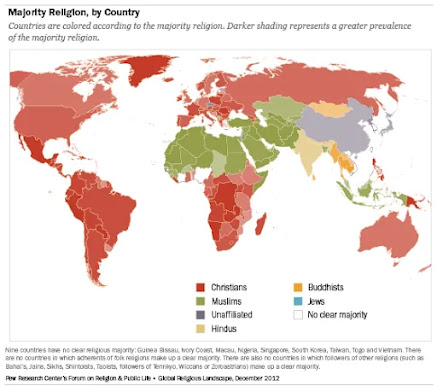Dr. Alice C. Linsley
I hope that readers have found the posts on Joseph Campbell, Raimon Panikkar, Carlos Castaneda, and Mircea Eliade helpful. I appreciate the contributions of these men, as far as they go. I wish they had pursued the antecedents of the religions that emerged in the Axial Age (c.1000 BCE - 200 CE). Antecedents provide the context and background information needed to better understand the origin, development, and causes that shaped the religious beliefs of populations of the ancient world.
When these men were writing, much of the data about the more archaic religions was not readily available. Today we do not have that excuse. We live in a world where information is more easily available and accessed.
Strangely, none of these men investigated the religion of Abraham's Hebrew ancestors and their influence on the ancient world (4000-2000 BCE). The religion of the early Hebrew priests predates Hinduism by at least 3000 years and predates Judaism by 3500 years. This exposes as a lie the notion that shamans represent an earlier stage of religious history than priests.
My research into the beliefs and social structure of the early Horite and Sethite Hebrew began only three years before Campbell died in 1987. Also, R. O. Faulkner's English translation of the Pyramid Texts, a valuable source of information about the Nilotic Hebrew, appeared in 1969.
Panikkar's work would have been more helpful if he had traced the roots of Hinduism to the early
Hebrew ruler-priest caste that moved out of Africa and established trade with the people of the Indus River Valley as early as 3000 BCE. The widely dispersed Hebrew caste spread elements of their belief in God Father and God Son wherever they settled in the service of high kings. They expected a universal ruler to overcome death. The idea of a universal king who is divinely appointed to rule is found in the oldest layers of Hindu thought. The Sanskrit word
cakravartin and the Pali word
cakkavattin refer to a righteous king who rules over the entire world. His "messianic" rule is called
sar-vabhauma.
From Africa to Nepal the words sar and sarki refer to rulers and priests. This is the root of the royal title Sar-gon, which means High King or King of Kings. Nimrod's Akkadian name was Šarru-kīnu, which is usually translated “the true king.” These words are related to the Akkadian words šarratum - queen, šarri - divine, and šarrum - king.
Beside the fact that much of what Castaneda wrote was fiction, his obsession with shamanic religion kept him from the intellectual understanding of that phenomena within the wider context of archaic religion. Shamans were only one religious office. The other religious office was the priest. Both shamans and priests serve as intermediaries between their communities and the supernatural. They share some common symbols such as the Tree of Life, serpent symbolism, and the Sun as the emblem of the
High God. However, they represent different worldviews, different ways of reasoning, and different practices.
Underlying shamanism is the belief that there are powerful spirits who cause imbalance and disharmony in the world. The shaman’s role is to determine which spirits are at work, to find ways to appease the spirits, and to restore balance or harmony. This often involves use of
psychoactive substances to induce a trance state. Rarely, does the shaman perform blood sacrifice. The hides used to make their drums come from animals that have been hunted for food.
Underlying the priesthood is belief in a supreme High God to whom humans must give an accounting, especially for the shedding of blood. The ancient laws and received traditions governing priestly ceremonies, sacrifices, cleansing and healing rituals clarify the role of the priest as one who offers sacrifice for the people according to sacred law.
Mircea Eliade wrote a great deal about shamans. Some of the healing practices of shamans were also done by the early
Nilotic physician priests. The two offices must point to transcendent reality to be effective. Eliade observed that all things "acquire their reality, their identity, only to the extent of their participation in a transcendent reality."
The history of religion during the lifetimes of these four men tended to focus on shamanic religions rather than on the religious traditions that have temple priests. The World Religions textbook that I used at Midway University (Kentucky) in the late 1990's made no distinction between the offices of shaman and priest. In the 1970's, the office of priest was denigrated due to sexual misconduct and ideological pressures from feminists and egalitarians.
Though raised a Roman Catholic, Joseph Campbell's exploration of myths focused mainly on the religions that emerged in the
Axial Age: Hinduism (the Upanishads), Judaism, Buddhism, Jainism, Daoism (Taoism), the Mediterranean mystery cults, Zoroastrianism, and Islam. His discussions of Nilotic myths involve the late syncretistic expressions of Egyptian imperialism. He does not explore the antecedents of the
Ra-Horus-Hathor narrative among the early Hebrew at
Nekhen (4200 BCE).
Conclusion
It is no longer credible to speak of Hinduism as the world earliest known religion. The religion of the early Nilotic Hebrew is much earlier. Information about them is found in the early biblical texts and in extra-biblical sources such as The Pyramid Texts (4000 BCE).
It is no longer credible to conflate the worldviews of shamans and priests. They pertain to two distinct cultural and geographical contexts. Both offices serve as mediators between their communities and the supernatural, but the differences in their ways of engagement must not be overlooked.
It is intellectually dishonest to pose the religions of the Axial Age as the original religions. The findings of archaeology and anthropology have exposed much early religious practices such as the 100,000-year practice of burial in red ocher, a
symbolic blood covering.

No comments:
Post a Comment